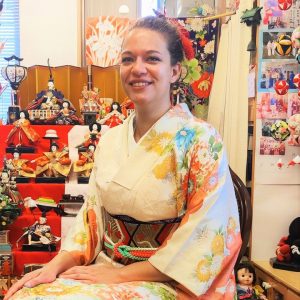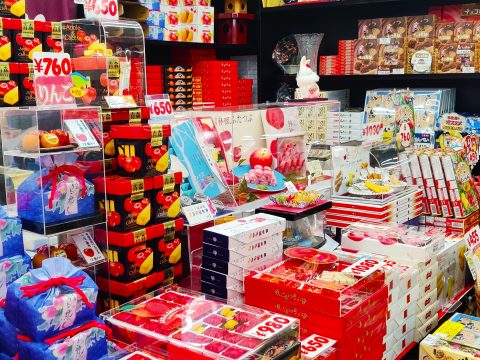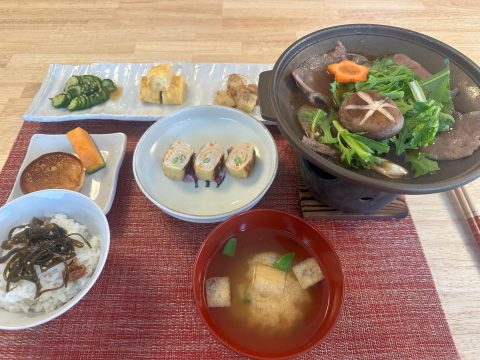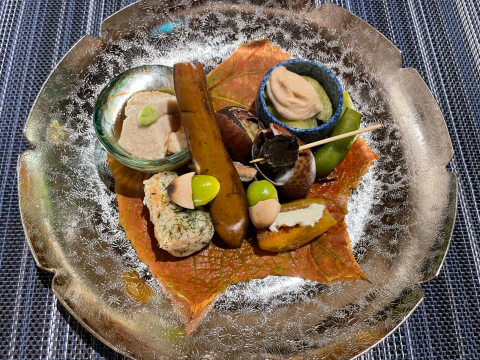Hanami(花見)
JAPANESE FOODS
26.03.2025
Although Japan has beautiful sights and interesting events to enjoy all year round, the most popular season for foreign tourists to visit is without a doubt spring. Also, Japanese residents tend to go out, explore, and travel more during this time for the same reason: sakura.
The Importance of Sakura
‘Sakura’ or cherry blossoms are Japan’s unofficial national flower and recognized worldwide as a symbol of the country”. There are many different types of sakura, but they all bloom rather briefly during spring and can be found everywhere in Japan. Depending on the area and the climate there, they start blooming from late January in the South (Okinawa) until late April in the North (Hokkaido). In Tokyo for example, they typically start blooming in late March. After they reach full bloom, they will only remain in full bloom for about 1 week. This is one of the reasons that sakura has become an important metaphor in Japanese culture. It shows us that life is brief and fragile, beauty is temporary and it must be appreciated for as long as it lasts. This is also why throughout history, sakura has played an important role in Japanese art, literature, and theater. Sakura and spring are also a symbol of new beginnings. The fiscal year begins on April 1st and schools start their new year around this day as well. In short, the sakura is deeply rooted in Japanese culture and stands for a lot more than simply ‘pretty flowers’.

What is hanami?
So how do people show their appreciation for sakura today? During springtime, the country’s most popular activity is ‘hanami’. Literally meaning ‘flower’ (hana) and ‘to view’ (mi) it is basically a nationwide picnic. Although the word hanami is also used to view different types of flowers, it is most common to view sakura. Everywhere in Japan, families, friends, and coworkers, flock to a park, walk around, have a picnic and admire the pink and white flower clouds that fill the sky. Most parks have one or more areas with many sakura trees planted close to each other. This results in a stunning view and the perfect setting to relax on a picnic sheet and share some food!
Hanami Food Traditions
There are no rules or customs regarding what type of food to bring to a hanami. When having a work–related hanami, there will usually be either a catering service which is sometimes even available through the park organization, or someone (usually the youngest employees) from the company will arrange food and drinks to be present when everyone arrives. In this case it is most common to have big platters of sushi, onigiri (rice balls) and sandwiches along with some tea, beer and canned cocktails.

When families have a hanami together, it of course depends on the family and the age of the children, what their usual tradition is. But in many cases, the mother will prepare some lunch boxes filled with onigiri, sandwiches and maybe some fruits, vegetables, omelets, and basically anything that is easy to bring and eat at a park.
Groups of friends tend to do a bit of both in my experience.
Buying Food for Hanami
Depending on the person, and whether they regularly cook or not, they might also prepare a few small dishes. Others, who for example live in a sharehouse or aren’t confident cooks, will usually buy food at supermarkets, specialty shops or food halls in department stores. Especially around this time of the year, many shops will sell large bento boxes to share. This way you can bring a large box full of karaage (fried chicken), yakitori (chicken skewers), gyouza (dumplings), potato salad, harumaki (spring rolls), but also pizza, bread, snacks, and basically anything else. Like most informal events in Japan, many people will also provide a decent amount of alcohol. And honestly, even if you will go to a crowded park alone, there is a very high chance that you will be invited to join a friendly group of locals, who would happily share some snacks and drinks with you.

Sakura–themed Snacks and Drinks
Speaking of snacks, there are many snack manufacturers that release sakura–themed products during springtime. In many cases, this is simply a change in packaging design, with lots of pink elements and of course sakura on temporary packages. Although in some cases, they actually add a seasonal product to their assortment, with sakura flavor. The same goes for drinks. While many beers will have sakura–themed cans, some sodas will actually be pink and have a sakura flavor.

Hana Yori Dango
Lastly, if there is one type of food that is most typical for hanami, it’s dango. These small pink, white, and green colored mochi (rice) balls on a stick are said to represent the life cycle of the sakura. The sakura bud is pink, when it blooms it turns white and after blooming, the leaves turn green. Another funny association is the phrase ‘Hana yori dango’. This literally means ‘dango (or sweets) before flowers’. It is commonly used as a way of saying one prefers substance over style. In this case however, it is often used as a joke, to say that people prefer eating and drinking over viewing the sakura.
So in the end, everyone has different ways and reasons to celebrate the sakura phenomenon. But if you get the chance to have a hanami when the sakura is at its peak, I promise you that you won’t regret it.

Mietta Varszegi
Mietta grew up in the Netherlands and moved to Japan in 2019 to work as an English teacher. Now, she has 3 different jobs, explores Tokyo on days off and takes trips around Japan whenever she can. But everywhere in Japan, the goal is the same: visit as many shrines, castles and parks as possible and eat everything!
Read previous articles by the writer
Read latest articles
KEYWORDS
- # PICKPICK
- # Resume
- # alcohol
- # Rice
- # Soup
- # winter food
- # Fast Food
- # seafood
- # spicy foods
- # raw food
- # fermented food
- # Transportation
- # MEAT
- # Edo culture
- # suits
- # clothing
- # drink
- # fish
- # seasoning
- # Japanese New Years Foods
- # Toshikoshi soba
- # Osechi Ryori
- # Ozoni
- # Christmas
- # Japanese fusion pasta
- # Wafu Pasta
- # Japanese Hot Pot
- # なべ
- # 鍋
- # Miyazaki
- # Chicken Nanban
- # Karamen
- # Autumn Wagashi
- # Mushi-yokan
- # Imo-yokan
- # Japanese Autumn Fruits
- # Autumn
- # Vending Machine
- # fall
- # dango
- # Chestnut rice
- # saury
- # Mushroom
- # Rice vinegar
- # Japanese condiments
- # 調味料
- # Sake
- # Mirin
- # Soy sauce
- # Japanese Noodles
- # Udon
- # Ramen
- # Yakisoba
- # Soba
- # Japanese Seaweed
- # 海藻
- # かいそう
- # Payslip
- # Training
- # Japanese summer foods
- # 和菓子
- # Wagashi
- # ryokucha
- # 夏
- # 飲み物
- # Ramune
- # ラムネ
- # Pokari Sweat
- # ポカリスエット
- # Calpis
- # カルピス
- # Mugicha
- # ume
- # 梅
- # うめ
- # umeshu
- # job hunting
- # tofu
- # Recruitment in Japan
- # miso
- # Japanese cuisine
- # Yellowtail and bonito
- # Children’s Day
- # Kashiwa Mochi
- # Chimaki
- # fruits
- # Kusamochi
- # Types of Agriculture in Japan
- # bread
- # パン
- # パン屋さん
- # japanese bread
- # shokupan
- # meal blead
- # anko bread
- # 桜
- # さくら
- # cherry blossom
- # visa
- # hanami
- # omotenashi
- # sakura
- # おもてなし
- # Japanese hospitality
- # oshibori
- # wet hand towel
- # hand towel
- # restaurant
- # Commuting in Japan
- # Women-only cars
- # Exit gate
- # japanese train
- # train
- # valentine
- # Japanese sweets
- # 朝食
- # Japanese Breakfast
- # Breakfast
- # Japanese
- # 日本
- # healthy
- # persimmons
- # hoshigaki
- # HR
- # work in Japan
- # jinji ido
- # corporate systems
- # Japanese work culture
- # bento
- # ekiben
- # shinkansen
- # omiyage
- # train station
- # Japanese culture
- # work culture
- # mentaiko
- # umeboshi
- # Japanese snacks
- # potato chips
- # Japanese potato chips
- # Japanese writing
- # seaweed
- # konbu
- # ocean foods
- # shio konbu
- # dashi
- # miso soup
- # food processing
- # pear
- # nashi
- # sweet potato
- # japanese sweet potato
- # stingray
- # satsuma imo
- # food value chain
- # homecooking
- # agriculture
- # Japanese homecooking
- # farming
- # nikujaga
- # shojin ryori
- # meat and potatoes
- # traditional foods
- # comfort food
- # buddhist food
- # manufacturing
- # factory
- # eihire
- # vegetarian
- # food and beverage
- # izakaya
- # yatai
- # japanese festival
- # taiyaki
- # matsuri
- # summer
- # Ikayaki
- # smart agriculture
- # shaved ice
- # kakigori
- # かき氷
- # summer dessert
- # Japan
- # Japanese foods
- # dessert
- # fruit
- # matcha
- # icecream
- # Pikcup
- # Pikc up
- # Pcikup
- # skilled labor visa
- # working visa japan
- # Dineer Table in Japan
- # Japanese manner
- # Japanese food
- # Japanese Table Manner
- # Chopsticks
- # Japanese traffic signs
- # traffic information
- # road rules in Japan
- # chocolate
- # green tea
- # Osaka
- # Work Japan
- # Japanese company
- # ikura
- # sushi
- # nigiri
- # wasabi
- # PCIK
- # PICK UP
- # PICK
- # PICKUP







